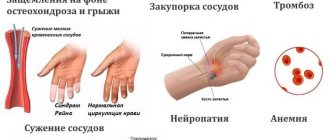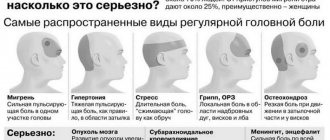Typical symptoms of numbness in the fingers of the right hand manifest themselves in the form of paresthesia. First of all, this is the loss of exteroceptive (superficial) sensitivity of one or several fingers at once. In addition, there are sensations of itching and crawling, as well as burning and coldness in the fingers.
With prolonged monotonous load or an uncomfortable position (when the hand is “numb”), this occurs due to a temporary disruption of the blood supply to the limb, as a result of which the conduction of nerve impulses changes. If after a few minutes after changing the position of the body (or rubbing the fingers) the numbness goes away, then this is exactly the indicated case.
With constant numbness in the fingers of the right hand, paresthesia becomes a sign of either a pathology of some part of the nervous system, or neurodegenerative processes, or autoimmune diseases (systemic lupus erythematosus). In this case, you need to seek medical help.
Symptoms of numbness in the fingers of the right hand, as well as the fingertips, as doctors note, in the vast majority of cases occur due to damage to nerve fibers due to osteochondrosis or are a consequence of compression of the nerve trunks due to pathologies of the peripheral nervous system.
Numbness of the little finger and ring finger of the right hand
Numbness of the fingers of the right hand is the most pronounced sign of tunnel neuropathies. The nerve trunks from the spinal cord to the fingertips go along special canals, which narrow in some places between the vertebrae. It is in these places that the nerve is compressed, which leads to the development of so-called tunnel syndromes or peripheral neuropathies, which account for 30% of diseases of the peripheral nervous system.
Thus, numbness of the little finger and numbness of the ring finger of the right hand can be the result of cubital tunnel syndrome (ulnar nerve compression syndrome). The ulnar nerve, which carries nerve impulses to the little finger and half of the ring finger, passes through the cubital canal, located behind the inside of the elbow.
Most often, numbness of the little finger and numbness of the ring finger of the right hand with ulnar nerve neuropathy can be observed when the elbow joint is in a bent state for a long time. That’s why those who work with their elbow resting on a surface (table, machine, etc.) often complain about similar symptoms. In addition, when the elbow joint is overloaded in drivers and musicians, with injuries in athletes, as well as during work associated with vibration, the joint and ligaments thicken. As a result, cubital tunnel syndrome occurs and its symptom appears - numbness of the right little finger and numbness of the ring finger of the right hand, which may be accompanied by pain when pressing on the elbow and weakness in the hand. You cannot let ulnar nerve neuropathy take its course: this can lead to atrophy of the muscles of the hand.
Numbness of the right thumb
Carpal or carpal tunnel syndrome (from the Greek karpos - wrist) causes numbness of the thumb of the right hand, numbness of the index finger of the right hand, numbness of the middle finger of the right hand and half of the ring finger. In this case, the median nerve is compressed as it passes through the carpal tunnel.
This happens from constant tension during prolonged static and dynamic load on one muscle group and on the wrist joint (for example, when working at a computer, as well as among painters, seamstresses, violinists). This syndrome is also called stenotic ligamentosis of the transverse ligaments by narrow specialists: with excessive loads on the hand, the tendons of the wrist joint swell and compress the nerve trunk. It is for this reason that the fingers become numb, and numbness in the fingers of the right hand often occurs at night, and in the morning a person may feel stiffness in finger movements.
Carpal tunnel syndrome can also appear with diseases such as arthrosis, arthritis, neurofibroma, hemangioma, etc. It is necessary to treat this syndrome, since the muscles of the thumb may atrophy, and a person will not be able to bend it.
Numbness of the index finger of the right hand
With dystrophic disorders in the cartilage of the vertebral joints - osteochondrosis - there is a decrease in their elasticity, strength and shape, which leads to pinching of nerve fibers. As a result, patients complain of pain in the neck, shoulder girdle and chest, frequent headaches, fatigue, changes in blood pressure, dizziness and tinnitus, impaired coordination of movements, and “spots” before the eyes. In addition, neurological manifestations of osteochondrosis of the cervical and thoracic spine are numbness of the index finger of the right hand. In this case, very often numbness is felt in the thumb.
Numbness of the index finger of the right hand can be a consequence of pathologies of the elbow joint, primarily such as arthrosis (epicondylosis) and arthritis. With arthrosis, the elbow joint begins to deteriorate and becomes inflamed, which leads to pain radiating to the hand, limited mobility of the arm at the elbow, numbness of the fingers and the inability to clench the hand normally into a fist.
And with arthritis of the right elbow joint, inflammation leads to a deterioration in the conduction of nerve impulses and numbness of the index finger of the right hand. Arthritis can occur as a result of infection, as well as after injury or constant overload of the elbow joint.
Numbness of the middle finger of the right hand
If, with partial loss of sensitivity in the index finger, there is numbness in the middle finger of the right hand, then doctors see the cause of this pathology in functional disorders of the intervertebral discs, cervical discs or cervical muscles. These disorders occur due to a compression effect on the nerve endings, which manifests itself not only in the form of paresthesia, but also weakness of the fingers, as well as pain in the forearm and shoulder.
Numbness of the middle finger of the right hand occurs when the distal processes of the nerve endings of the radial nerve are damaged. That is, it is a peripheral neuropathy that can develop after stretching or tearing a nerve, for example, with subluxation of the elbow joint. But the most common cases involve carpal tunnel syndrome, which was mentioned earlier.
The feeling of tingling and numbness in the limbs is familiar to every person. It can be either a symptom of another disease or nothing more than just an unpleasant feeling. It is important which area of the body loses sensitivity:
- If the right arm goes numb from the shoulder to the fingers, the causes may be cervical osteochondrosis, arthrosis, or a sharp narrowing of the blood vessels in the neck. Less often, this is a harbinger of a stroke.
- When two or more fingers on your left hand go numb, you should consult a cardiologist to check for heart disease. Seek immediate medical attention if the pressure is felt continuously or regularly over a long period of time. This may be a signal of a stroke or mini-stroke.
- If tingling and numbness are observed in both hands, the source of the problem is a disruption of the central nervous system. Possible ailments:
- Intervertebral hernia;
- Polyneuropathy;
- Cervical osteochondrosis.
However, there are other reasons as well. Let's look at them all in more detail.
Fingers on the left and right hand go numb: reasons
Most often, numbness in the fingers on both hands at once may indicate that a person has:
- Cardiovascular diseases . With such pathologies, there is a disturbance in blood circulation, and if its quality is affected specifically in the area of the hands, then patients often experience numbness in the fingers.
- Peripheral neuropathy is a disease in which peripheral nerves are affected due to injuries, infections, and systemic pathologies. They become incapable of high-quality transmission of impulses. Numbness of the fingers and other parts of the hands may be accompanied by tingling, a feeling of squeezing of the limbs (a person feels as if he is wearing tight gloves), and thinning of the skin.
- Raynaud's disease . With this pathology, blood flow in small vessels is disrupted - usually in the hands or feet. That is why it is one of the most common reasons why fingers go numb. A person with this pathology is vulnerable to infectious diseases. Associated symptoms are: pale skin, tingling, burning. As the disease worsens, the fingers may become sore and turn blue in the cold. The above symptoms appear under the influence of stress, emotional overload, and temperature changes. Numbness appears symmetrically on both hands.
- Arthritis, arthrosis or bursitis . With these diseases, nerves are compressed, which can cause numbness.
- Vitamin deficiency . If you are wondering why your fingertips are numb, then it is quite possible that your body is lacking some vitamins and minerals.
- Endocrine disorders . Numbness of the fingers is often observed with diabetes and hypothyroidism.
Less common reasons why the fingers of both hands go numb include:
- anemia;
- multiple sclerosis;
- cirrhosis of the liver.
Important! Numbness often occurs in pregnant women. The expectant mother’s body is being rebuilt, because it now needs to work in “enhanced mode.” The volume of blood circulating in it also increases. Because of this, circulatory disorders and, as a result, numbness of the fingers can sometimes be observed. After childbirth it usually goes away. However, if such a symptom is observed during pregnancy, you must inform your doctor about it: it may be necessary to take measures to improve blood circulation.
What if the fingers of only one hand go numb? Here may be your own list of diseases:
- Tunnel syndrome (carpal tunnel syndrome). This is a neurological disease caused by pinching of the median nerve. It often occurs in people whose work involves monotonous manual activity. For example, pianists, sign language interpreters, drummers, artists, etc. are at risk. And, of course, representatives of any professions that involve frequent use of a computer. Previously, carpal tunnel syndrome was called “typist’s disease.” With this disease, numbness of the fingers is accompanied by pain in the wrist area.
- Osteochondrosis of the thoracic and cervical spine . In this case, the fingers usually go numb at night.
- Pre-stroke condition . Numbness of the fingers is accompanied by severe headache and increased blood pressure.
- Thrombosis of the upper limb . When an artery is blocked by a blood clot, at first only the fingers become numb. But gradually this condition spreads to other parts of the hand.
In addition to internal ones, there are also external causes of numbness in the fingers on one or both hands. These include:
- Uncomfortable sleeping position or poor-quality sleeping place (with bumps, dents). In this case, the fingers go numb in the morning. Getting rid of this condition is quite simple. It is necessary to bend your fingers, raising your arms up.
- Tight clothing, squeezing jewelry (bracelets, rings).
- "Lovers Syndrome" Some people do not want to be separated from their soulmate even in their sleep. A woman falls asleep on her lover's shoulder, and in the morning he wakes up with numb fingers.
If you have eliminated all of the above external causes, and the numbness does not go away, you should pay attention to your health.
Fingers go numb: what to do
If you regularly experience numbness in your fingers, then you cannot let the situation take its course. Despite the fact that this condition does not always indicate the presence of diseases, the patient cannot determine for himself whether he needs medical help or not. Therefore, you should definitely consult a doctor. Before doing this, it is recommended to monitor your condition and write down the answers to the following questions:
- How often and at what time of day do your fingers go numb, all or just some of them? On one or both hands?
- Is this condition accompanied by other symptoms? Which ones?
Having such a “blank” will make it easier for you to answer the doctor’s questions when he collects an anamnesis.
Important ! What you definitely shouldn’t do is self-medicate. You may even be able to temporarily relieve the discomfort. But the cause of numbness itself will not disappear. This is dangerous not only because the symptom may return: without medical help, the existing disease can worsen. He will still have to be treated, but then it will be more difficult and longer.
Numbness of the thumb and index finger
The thumb is more vulnerable than its fellow toes and is often the first to go numb. Often he suffers “in a duet” with the index finger. This may be due to the following reasons:
- inflammatory processes;
- compression of the median nerve;
- excessive stress on the wrists;
- diseases of the spine.
Will tolerate the middle, ring and little fingers
Numbness of the middle and ring fingers, as well as the little finger, may indicate:
- cardiovascular pathologies;
- diseases of the elbow joint;
- intoxication of the body (during alcohol abuse, smokers);
- infringement of the brachial nerve plexus.
Numb fingertips = nerve damage?
In only 0.1% of cases, numbness in the fingertips indicates nerve damage. Typically, such an injury manifests itself more extensively: the entire arm immediately goes numb. If you managed to avoid such a fate and numbness in your fingers occurs infrequently, you can calm down. But if it gets worse with each new workout, you should consult a doctor. The condition may worsen due to several factors:
- alcohol abuse;
- cardiovascular diseases;
- neurological problems;
- diabetic neuropathy;
- hypothyroidism;
- vitamin B deficiency.
Even if finger numbness occurs after exercise, it may have nothing to do with lifting weights at all. Especially if it is accompanied by general weakness and absent-mindedness. And if you are worried about an isolated incident, rest assured: 5 minutes of numbness or tingling in your fingers cannot be a consequence of nerve damage.
Possible diseases
Above, you have already become familiar with some diseases that can cause numbness in your fingers. Now we invite you to familiarize yourself with a more detailed list of pathologies that may have such a symptom:
- hand and spine injuries;
- damage to the heart and/or blood vessels;
- intervertebral hernia;
- Hansen's disease;
- metabolic disorders;
- diseases of the spine and joints;
- hygromas (tumor-like benign neoplasms);
- hyperventilation;
- some autoimmune conditions;
- syphilis;
- Lyme disease (tick-borne borreliosis);
- pathologies of the brain and spinal cord;
- vasculitis (inflammation of blood vessels);
- HIV and AIDS;
- diseases of the nervous system.
Which doctor should I contact?
It is difficult for the patient to determine why his fingers are going numb. Accordingly, choosing a specialist in this situation is not easy. Therefore, the best option is to consult a therapist. He will examine the patient and refer him for laboratory diagnostics. And if necessary, he will guide you in choosing a specialist.
Treatment for hand numbness at the doctor
Treatment can be either conservative (drug therapy) or surgical (or complex) - much depends on what disease caused the numbness in the fingers. The following will help you relieve this unpleasant symptom:
- Massage and manual therapy . Such events can relieve the patient of unpleasant sensations and improve his quality of life.
- Physiotherapy . Ultrasound and magnetic therapy and laser treatment show high effectiveness. These procedures accelerate tissue regeneration.
- Physiotherapy . Indispensable for normalizing blood circulation.
The patient’s personal initiative will also be beneficial - he can also help his body by changing his lifestyle:
- Eat properly and balanced . This is especially true for vitamin deficiencies, anemia, and metabolic disorders.
- To refuse from bad habits . Fingers often go numb in people who are addicted to smoking or abuse alcohol.
- Pay attention to physical activity . This will improve blood circulation, and it is precisely its violation that is often the “root of evil.”
It should be remembered that numbness in the fingers can occur not only due to lack of physical activity, but also due to overload of the hands. Everything is good in moderation! If you are forced to constantly load your arms with monotonous activities, try to do several simple exercises every hour to help relax your muscles. You can raise and lower your arms, clench and unclench your fists, and swing.
Stay healthy and remember to give your arms both rest and moderate exercise.
Possible reasons
Numbness of the fingers can be caused by both physiological and pathological reasons
The reason why three fingers on the right hand go numb may be of a pathological nature or may be a manifestation of circulatory disorders due to poor sleep or an awkward position, prolonged sitting in an uncomfortable position, monotonous movements or overwork due to constant repetition of the same actions.
Most often this happens in a dream or if a person dozes off at work, on a trip, during an air flight, while sitting in a chair in a constrained position. But sometimes such phenomena indicate the presence of pathology in the body, and it is impossible to explain their appearance simply by fatigue.
Most often, the location on the arm indicates the cause of numbness:
- The problem with sensitivity in the fingers of the right hand is usually associated with carpal tunnel syndrome, polyneuropathy, Raynaud's disease, pinched nerve endings in the cervical and thoracic spine, arthrosis, and spinal hernias. Basically, the lesion divides the fingers into two parts - either the little finger and ring finger, or the thumb and index finger fall into the zone of action. The middle finger can be affected on both sides.
- Numbness of the little finger and ring finger is mainly due to problems with the ulnar nerve and the small endings coming from it. This condition can also be provoked by compression injuries of the upper spine, bruises of the elbow and hand, complex fractures and other injuries.
- The middle finger often suffers as a result of damage to the nerves and blood vessels of the entire hand, since it has the richest and most complex innervation. Often, middle finger reaction is caused by lesions that affect the adjacent fingers and the entire hand. A feeling of numbness in three fingers - the middle, ring and little fingers, especially their tips, may indicate the presence of pathology in the cardiovascular system, and be a harbinger or symptom of a developing heart attack or stroke.
- Pain and pins and needles in the thumb indicate problems with joints, nerve endings and blood vessels. If three fingers are pulled into the condition at once, then this is most often a sign of serious difficulties with blood circulation, an indication of thrombosis or the presence of a stroke affecting the right half of the body.










